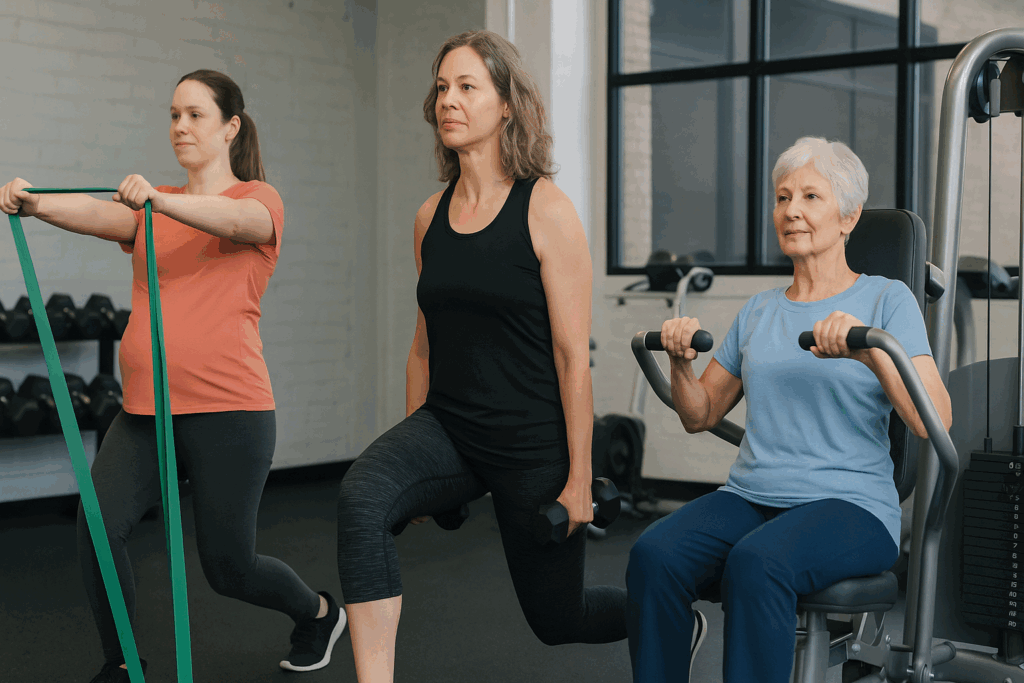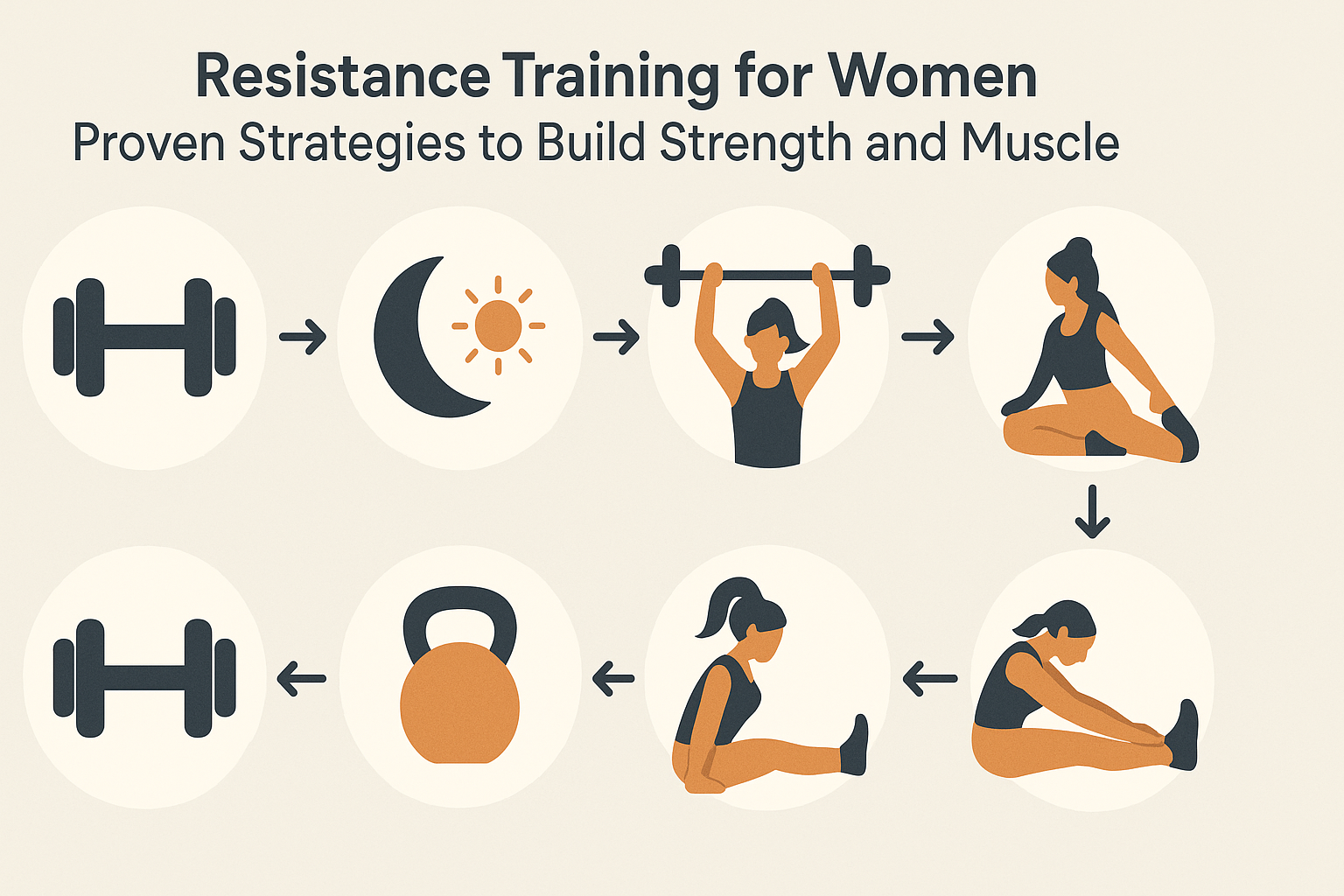In recent years, resistance training for women has gained traction not just as a fitness trend, but as a transformative, empowering discipline grounded in scientific research and real-world results. More than a method to sculpt the body, resistance training represents a profound shift in how women view strength, capability, and long-term health. Once dominated by myths that painted weightlifting as unfeminine or intimidating, today the narrative has changed. Women of all ages and fitness levels are embracing resistance training for its proven capacity to increase muscle mass, enhance metabolic function, support hormonal balance, and build the resilience needed for a high-quality life. This ultimate guide is a comprehensive exploration into the essential knowledge, strategies, and techniques that underpin effective resistance training for women.
You may also like: The Ultimate Hypertrophy Workout Program for Building Strength and Size

Understanding Resistance Training: Foundations and Misconceptions
At its core, resistance training involves any activity that causes the muscles to contract against an external resistance with the expectation of increases in strength, tone, mass, or endurance. This resistance can take many forms—free weights, resistance bands, body weight, or machines—but the biological mechanisms remain the same. When subjected to repeated bouts of controlled stress, muscles adapt and grow stronger.
Despite its benefits, female weight training has historically been clouded by misconceptions. The most prevalent of these myths is the belief that lifting weights will cause women to become excessively muscular or “bulky.” In reality, women generally do not possess the levels of testosterone necessary to build large muscle mass like their male counterparts. Instead, the result is often a leaner, more defined physique that reflects strength without sacrificing femininity. Furthermore, resistance training supports bone density, heart health, and psychological well-being—benefits that extend far beyond aesthetics.
Scientific literature also supports resistance training as a tool for long-term metabolic enhancement. Muscle tissue is metabolically active, meaning it burns calories even at rest. Thus, increasing muscle mass through strength training for women can significantly boost resting metabolic rate, making it easier to maintain a healthy weight over time. For women entering perimenopause or menopause, this metabolic advantage can play a pivotal role in managing hormonal shifts and preserving vitality.

Designing a Resistance Training Program That Works
Crafting an effective resistance training program begins with understanding individual goals, fitness levels, and lifestyle factors. A well-rounded routine should address all major muscle groups, ensure appropriate recovery, and be sustainable over the long term. For women new to resistance training, starting with two to three full-body sessions per week is a practical and effective approach. As adaptation occurs, frequency and intensity can be progressively increased.
Each workout should begin with a dynamic warm-up to prepare the muscles and joints for activity. Compound movements such as squats, lunges, deadlifts, and presses should form the foundation, as they engage multiple muscle groups and stimulate greater hormonal responses. These exercises mirror natural movement patterns, enhancing not only strength but also functional fitness that translates to everyday life.
Programming should include a mix of rep ranges to target various muscle fibers. Lower reps (4-6) at higher weights build maximal strength, while moderate reps (8-12) are optimal for hypertrophy, or muscle growth. Higher reps (15-20) can improve muscular endurance. Alternating between these ranges over the course of several weeks allows for comprehensive muscular development.
Progressive overload is the cornerstone of any successful program. This means consistently challenging the muscles with greater resistance, volume, or complexity over time. Without progressive overload, the body will quickly adapt, and further gains will plateau. Tracking progress—whether through training logs, performance metrics, or physical measurements—is essential for accountability and motivation.

The Unique Physiology of Women in Resistance Training
While the fundamental principles of resistance training apply to all humans, certain physiological factors make female weight training a unique endeavor. Hormonal fluctuations across the menstrual cycle can influence strength, recovery, and perceived exertion. Research suggests that strength levels may be slightly higher during the follicular phase (days 1-14) and lower during the luteal phase (days 15-28), though individual experiences vary.
Women also tend to have a higher proportion of type I (slow-twitch) muscle fibers, which are more resistant to fatigue and well-suited for endurance. This means that women may perform better with slightly higher rep ranges and shorter rest intervals. Moreover, females often exhibit greater lower-body strength relative to their upper bodies, necessitating a tailored approach that ensures balanced development.
Resistance training for women must also take into account life stages such as pregnancy, postpartum, and menopause. During pregnancy, modified strength training has been shown to reduce the risk of gestational diabetes, promote healthy weight gain, and improve labor outcomes. Postpartum, resistance training aids in restoring core strength and mitigating postpartum depression. In menopause, strength training becomes critical for preserving bone density and mitigating the effects of declining estrogen levels.

Nutrition and Recovery: Pillars of Progress
No training program is complete without proper nutrition and recovery strategies. To support muscle growth and strength development, women must consume adequate protein, carbohydrates, and healthy fats. Protein intake is particularly vital, as it provides the amino acids necessary for muscle repair and synthesis. A general guideline is 1.2 to 2.0 grams of protein per kilogram of body weight per day, depending on training intensity.
Carbohydrates serve as the primary energy source during high-intensity workouts, while dietary fats play key roles in hormone production and cellular health. Micronutrients such as calcium, vitamin D, magnesium, and iron are also crucial, especially for women engaged in regular training. Supplementation may be beneficial when dietary intake falls short, but should always be approached under the guidance of a healthcare professional.
Equally important is the role of recovery. Resistance training creates microtears in muscle fibers, which must be repaired during rest in order to grow stronger. Adequate sleep, active recovery, mobility work, and hydration all support this process. Overtraining without sufficient rest can lead to fatigue, injury, and diminished performance. For optimal results, recovery should be viewed not as downtime, but as an integral component of progress.
Building Confidence and Overcoming Barriers in the Gym
Psychological and social barriers often deter women from engaging fully in weight training for women. Common obstacles include fear of judgment, intimidation in male-dominated gym environments, and uncertainty about proper form or programming. These challenges are valid and widespread, yet they can be systematically dismantled through education, community, and experience.
Confidence grows through competence. Working with a knowledgeable coach or attending group strength classes can provide a supportive environment for skill acquisition. Video tutorials and online platforms also offer accessible instruction on exercise technique. As proficiency increases, so does self-efficacy—a key predictor of long-term adherence to resistance training.
Creating a routine that feels empowering rather than burdensome is also essential. For some, this might mean training in the privacy of a home gym. For others, it could involve joining women-centric training spaces where mutual encouragement and shared goals foster belonging. Regardless of the setting, cultivating a positive relationship with strength training allows women to redefine their physical potential.
Optimizing Hormonal Health with Strength Training
Strength training for women offers profound benefits for hormonal regulation. Regular resistance training improves insulin sensitivity, which helps to stabilize blood sugar levels and prevent metabolic disorders such as type 2 diabetes. It also positively influences cortisol levels, mitigating the effects of chronic stress when paired with proper recovery practices.
For women with polycystic ovary syndrome (PCOS), strength training has been shown to reduce androgen levels, regulate menstrual cycles, and support weight management. Similarly, during menopause, resistance training helps to counteract the loss of estrogen by stimulating bone growth and preserving muscle mass. Hormonal health is not only vital for reproductive function, but also for mood, cognition, and energy levels.
It is essential, however, to approach strength training with balance. Excessive intensity or insufficient rest can lead to hormonal disruptions, particularly in women with high training volumes. Listening to the body, periodizing training, and prioritizing recovery are fundamental to sustaining hormonal harmony over time.
Integrating Resistance Training Into a Busy Lifestyle
Time constraints are one of the most frequently cited barriers to consistent exercise, yet resistance training is uniquely adaptable to a range of schedules. Effective strength workouts can be completed in as little as 30 minutes, especially when utilizing full-body circuits or supersets that minimize rest periods while maximizing output.
For women balancing careers, family obligations, or academic pursuits, efficiency is key. Scheduling workouts in advance, packing gym clothes the night before, or incorporating short bodyweight routines at home can facilitate consistency. The goal is not perfection, but sustainability. Even two weekly sessions can yield significant strength gains when performed with intention and focus.
Technology can also serve as an ally. Apps, virtual trainers, and online communities provide guidance, accountability, and camaraderie. By embedding resistance training into the fabric of daily life—rather than treating it as an isolated event—women are more likely to adhere to their fitness goals and experience long-term success.

Enhancing Mental Health Through Resistance Training
Beyond the physiological benefits, resistance training for women has a profound impact on mental and emotional well-being. Studies consistently show that strength training reduces symptoms of anxiety, depression, and chronic stress. It fosters a sense of mastery, resilience, and autonomy—qualities that extend into all areas of life.
The act of lifting weights encourages mindfulness and presence. With each repetition, the practitioner must focus on breath, posture, and intention. This meditative quality not only enhances performance but also cultivates a deeper connection between body and mind. Over time, resistance training becomes more than exercise; it becomes a practice in self-respect and self-discovery.
For women who have experienced trauma or body image struggles, strength training can offer a pathway to healing. Reclaiming physical strength often parallels the reclamation of agency and confidence. The mirror no longer reflects inadequacy, but rather capability and courage. As such, resistance training holds the potential to empower women not just physically, but psychologically and spiritually.

Resistance Training for Women: Proven Strategies to Build Strength and Muscle
To truly harness the benefits of resistance training, women must employ strategies that align with both scientific principles and individual needs. Periodization—the systematic planning of training phases—allows for targeted progress and injury prevention. For example, alternating between hypertrophy and strength cycles ensures balanced development and avoids burnout.
Exercise variation is another critical strategy. While consistency is important, the body adapts to repetitive stimuli. By rotating exercises, equipment, and training modalities, women can challenge different muscle fibers and stimulate continued growth. Functional movements, unilateral exercises, and mobility work all contribute to a comprehensive program.
Tracking progress is a powerful motivator. Whether through strength benchmarks, body composition changes, or simply improved energy levels, celebrating milestones reinforces commitment. Journaling, photos, and fitness apps are valuable tools for reflection and recalibration. Above all, patience is essential. Strength is not built overnight, but through disciplined effort and unwavering belief in one’s potential.

Creating a Supportive Environment for Long-Term Success
Environment shapes behavior. Surrounding oneself with people who value and support resistance training can significantly influence consistency and motivation. This might include training with a partner, joining a fitness community, or following inspiring coaches online. Social support has been shown to enhance exercise adherence and enjoyment.
Moreover, cultivating intrinsic motivation—the desire to train for personal fulfillment rather than external validation—is key. When strength training is viewed as a celebration of the body’s capacity rather than a punishment for its imperfections, it becomes a source of empowerment. Setting goals that are meaningful, specific, and aligned with one’s values creates a lasting sense of purpose.
Women should also feel empowered to advocate for their needs in gym environments. Asking for equipment, requesting modifications, or challenging gender stereotypes requires courage but fosters progress. By redefining what it means to be strong, women contribute to a broader cultural shift that values female strength in all its forms.
Frequently Asked Questions: Resistance Training for Women
What makes resistance training for women especially beneficial during different life stages?
Resistance training for women provides stage-specific health advantages that are often overlooked in mainstream fitness discussions. During adolescence, it can support bone development and enhance coordination, which is especially important given that young women are at higher risk for developing conditions like scoliosis and osteoporosis later in life. In the reproductive years, weight training for women may help alleviate symptoms of PMS and increase insulin sensitivity, contributing to better energy and mood stability. During pregnancy, modified resistance workouts can reduce lower back pain, promote healthy weight gain, and enhance pelvic floor strength, potentially easing labor and postpartum recovery. As women transition into perimenopause and menopause, female weight training becomes a powerful tool in maintaining muscle mass, preserving bone density, and regulating hormonal fluctuations that affect everything from sleep to metabolism.
How does resistance training support cognitive health in women?
Emerging research indicates that strength training for women can play a significant role in preserving cognitive function. The neuromuscular coordination required for complex lifting patterns stimulates the brain in ways that are distinct from aerobic exercise. This kind of training improves executive function, working memory, and even verbal reasoning. Moreover, resistance training has been shown to increase levels of brain-derived neurotrophic factor (BDNF), a protein linked to neuroplasticity and the growth of new brain cells. Women who consistently engage in resistance training may also experience enhanced focus, reduced brain fog, and sharper decision-making skills, especially important for aging populations concerned with cognitive decline.
Is there a difference in how women respond to free weights versus resistance machines?
Yes, the modality of equipment used in weight training for women can affect both the physiological response and the skill development associated with each exercise. Free weights require more core stabilization, joint mobility, and neuromuscular coordination, making them ideal for building functional strength and improving balance. Machines, by contrast, offer a more controlled movement path, reducing injury risk for beginners and allowing isolation of specific muscles. While both tools have their place in a well-rounded program, a blend of free weights and machines often yields the best outcomes. Women recovering from injury or those new to strength training for women may find machines useful as an entry point before progressing to more complex movements.
What role does resistance training play in managing chronic health conditions in women?
Resistance training for women has proven benefits in managing various chronic health conditions beyond musculoskeletal issues. For instance, it can significantly improve glycemic control in women with type 2 diabetes by increasing glucose uptake in skeletal muscles. Those with hypertension may see reductions in both systolic and diastolic blood pressure due to the vasodilation effects associated with regular strength work. Moreover, resistance training has been linked to decreased inflammation markers, aiding in the management of autoimmune conditions such as lupus and rheumatoid arthritis. It also supports mental health management, contributing to the reduction of depressive symptoms, especially when integrated into a holistic care plan that includes therapy and nutrition.
How should women tailor their training around the menstrual cycle?
Adapting weight training for women to align with menstrual cycle phases can enhance both performance and recovery. In the follicular phase (first half of the cycle), women typically experience higher energy levels and greater pain tolerance, making it an optimal time for heavy lifting or high-intensity training. The luteal phase (second half), especially the week before menstruation, may bring fatigue, bloating, or reduced coordination. During this time, lighter resistance, mobility-focused sessions, and increased rest days can be more appropriate. Tracking cycles over several months allows women to observe patterns and develop a responsive training schedule that enhances consistency and reduces the risk of overtraining or burnout.
Can resistance training improve posture and spinal health in women?
Yes, resistance training for women has a transformative impact on postural alignment and spinal integrity, particularly important for those with sedentary occupations. Strengthening the posterior chain—including the glutes, hamstrings, spinal erectors, and upper back—helps counteract the effects of prolonged sitting, which often leads to forward head posture, rounded shoulders, and lower back discomfort. Exercises like deadlifts, rows, and scapular retractions not only build muscular balance but also retrain neuromuscular pathways to hold proper alignment more naturally. Improved posture can reduce chronic pain, enhance breathing efficiency, and even boost confidence through more upright body language. Over time, these benefits contribute to a more resilient musculoskeletal system and a decreased risk of age-related spinal degeneration.
How can resistance training support women with high-stress lifestyles?
Strength training for women is a powerful tool for combating the physical and psychological toll of chronic stress. Engaging in resistance exercises triggers the release of endorphins and dopamine, promoting a natural mood elevation that counters stress hormones like cortisol. Structured routines also offer a sense of control and accomplishment, which can be particularly grounding for women juggling careers, caregiving roles, and other life demands. Unlike high-impact cardio, which can sometimes exacerbate adrenal fatigue, resistance training supports nervous system regulation when performed with adequate rest intervals. Over time, it helps reset the body’s stress response, leading to improved sleep, sharper focus, and better emotional resilience.
What are the latest innovations in strength training for women?
The field of female weight training is evolving rapidly, with technology and science offering new methods for personalization and optimization. Wearable devices now track muscle activation, rep cadence, and heart rate variability to fine-tune training loads in real time. Virtual reality (VR) strength training environments provide immersive experiences that boost motivation and engagement, especially for those training at home. Additionally, blood flow restriction (BFR) training is gaining popularity among women seeking muscle growth with lighter weights, making it especially useful during rehabilitation or pregnancy. There’s also a growing interest in velocity-based training, which uses bar speed as a metric to adjust loads dynamically, ensuring progressive overload without compromising form.
What strategies can help overcome plateaus in female weight training?
Plateaus are a common but solvable challenge in weight training for women. To break through, it’s essential to reassess variables like volume, intensity, and exercise selection. One effective method is to implement deload weeks, where overall load is reduced to allow the nervous system and muscles to recover fully. Another strategy involves incorporating novel training stimuli such as unilateral movements, resistance bands, or tempo manipulation—slowing down the eccentric portion of a lift can reignite muscle adaptation. Psychological factors also play a role, and addressing mental fatigue through visualization, goal reframing, or working with a coach can renew motivation. Nutritional changes, such as increasing protein or adjusting macronutrient timing, can further support renewed progress.
Why is community support vital for long-term adherence to resistance training for women?
Community plays a pivotal role in sustaining motivation and consistency in resistance training for women. Shared experiences create emotional accountability, making it easier to overcome self-doubt and isolation. Whether through in-person classes, online forums, or training with a friend, women often thrive in environments that encourage mutual support and recognition. These communities offer valuable feedback, celebrate milestones, and can even provide access to resources like expert guidance and advanced programming. Moreover, seeing peers navigate similar challenges fosters a sense of belonging and resilience, which is particularly crucial for beginners or those returning after a hiatus. As social beings, women are more likely to stay engaged and push past obstacles when they feel seen and supported by others on a similar path.
Conclusion: Embracing the Power of Resistance Training for Women
Resistance training for women is more than a fitness modality—it is a transformative journey that cultivates strength, resilience, and self-mastery. Through deliberate practice, informed strategies, and unwavering commitment, women can harness the power of resistance training to achieve physical, mental, and emotional well-being. This comprehensive guide has explored the science, psychology, and practical applications of resistance training, offering a roadmap for lasting success.
As more women embrace the barbell, the dumbbell, or even their own body weight, they redefine cultural narratives and challenge outdated norms. They discover that strength is not confined to appearance, but radiates from within. In lifting weights, women also lift themselves—into a space of confidence, health, and empowered living. Whether you are just beginning your journey or seeking to deepen your practice, resistance training offers a lifelong path to vitality and strength. Embrace it with courage, intelligence, and joy.
Further Reading:
Strength Training For Women: Tone Up, Burn Calories, Stay Strong





